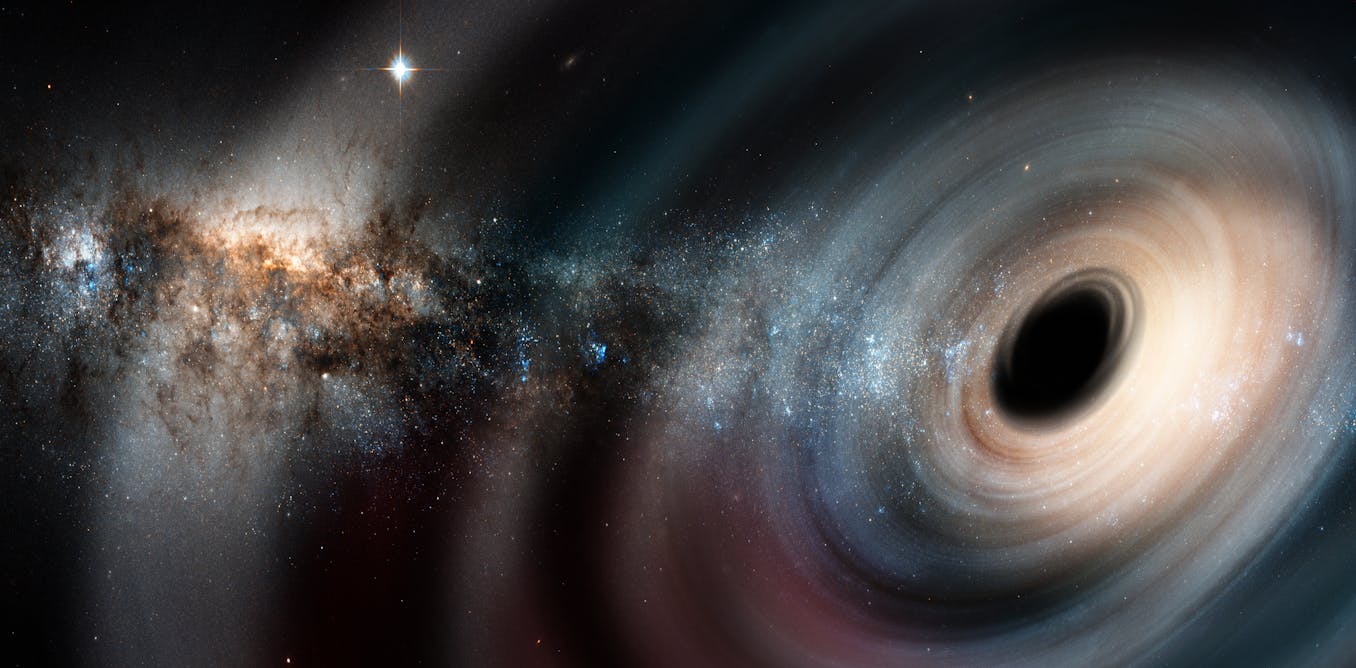
A spinning black hole is such an extreme force of nature that it drags time and the surrounding space with it. Therefore, it is natural to wonder if black holes could be used as some kind of energy source. In 1969, mathematical physicist Roger Penrose proposed a method for doing just this, now known as the “Penrose Process”.
The method could be used by sophisticated civilizations (aliens or future humans) to collect energy by making “black hole bombs”. However, some of the physics required to do so has never been experimentally verified, until now. Our study confirming the underlying physics has just been published in Nature Physics.
Around its event horizon (the boundary around a black hole beyond which nothing, not even light, can escape), a spinning black hole creates a region called the “ergosphere.” If an object falls into the ergosphere in such a way that it divides, with one part falling into the black hole and the other escaping, the part that flees effectively gains energy at the expense of the black hole. So by sending objects or light into a spinning black hole, we could recover energy.
But does this theory hold? In 1971, Russian physicist Yakov Zel’dovich translated it into other rotary systems that could be tested on Earth. The black hole became a rotating cylinder made of a material that can absorb energy.
Zel’dovich imagined that light waves could draw energy from the cylinder and amplify. However, for the amplification effect to work, these waves must have something called “angular momentum,” which twists them into spirals.
When twisted light waves hit that cylinder, its frequency should change due to something called a “Doppler shift.” Chances are, you have experienced this by hearing an ambulance siren. When it moves towards you, it has a higher pitch than when it moves away from you: the direction of travel changes the pitch of the sound. Similarly, changes in rotational speed alter the perceived frequency of a light wave.
If the cylinder rotates fast enough, the altered wave frequency should drop so low that it will become negative (which simply means that the wave rotates in the opposite direction).
The positive frequency waves must be partially absorbed by the cylinder, losing energy. But negative frequency waves would transform this loss into gain, and instead the cylinder would amplify it. They would draw energy from the rotation, just like the object escaping from Penrose’s black hole.
Testing Zeldovich’s theory may seem simple. But the rotating object needs to rotate at the same frequency or higher than the waves. To amplify visible light waves, which oscillate at a rate of hundreds of billions of times per second, you would need to rotate an absorbing object billions of times faster than anything mechanically possible today.
Advance at last
Light travels at about 300 million meters per second. So, to make the theory easier to test, we opted to use sound waves, which travel about a million times slower, which means we don’t need the absorber to rotate that fast.
To create a twisted sound wave, we use a ring of speakers that all emit the same frequency but start at slightly different times, making the sound spiral. For our rotary absorber, we use a piece of sound absorbing foam attached to a motor. The microphones placed inside the foam allowed us to record the sound after having interacted with the rotating absorber.
We found that when the foam spread slowly (at low frequency), the sound we recorded was quieter because it had been absorbed by the foam. But when we rotated the foam fast enough for the Doppler to change the frequency of the sound waves enough to make them negative, the sound grew louder.
This can only mean that the sound wave has taken energy from our spinning absorber, which finally demonstrates the 50-year theory.
Black hole pump
Of course, all of this does not explicitly verify that Penrose’s idea of energy extraction really works for a black hole. Rather, our experiments verify counterintuitive underlying physics by showing that changing wave frequencies from positive to negative results causes waves to gain rather than lose energy.
While we are not close to extracting energy from a spinning black hole, this does not mean that it cannot be done by a highly advanced alien civilization, or our own civilization in the distant future. Such a civilization could build a structure around the spinning black hole and then throw asteroids or even electromagnetic waves at what would be reflected with more energy.

wikipedia, CC BY-SA
Even better, they could build a so-called black hole bomb by completely surrounding the black hole with a reflective mirror housing. The light that was shining into the black hole would come back amplified, and then be reflected back to the black hole by the mirror to amplify again, and so on.
The energy would increase exponentially in a fugitive round trip explosion. But by allowing some of this amplified light to exit the housing through a hole, you can control the process and produce essentially limitless energy.
Although this is still science fiction, in the very distant future when the universe is dead and the only remnants of galaxies and stars are black holes, this method would be the only hope for a civilization to survive. This would be a universe with immense and isolated sources of energy, glowing in a completely black sky.